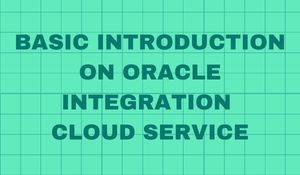
Brief Intro OICS
Oracle Integration Cloud Service sets up you to connect your applications in the cloud whereas it is a complete, secure, but unintellectual integration solution. It simplifies connectivity between your applications. It also connects both the cloud application and the on-premise application. Oracle Integration Cloud Service provides native connectivity to (SaaS) Oracle Software as a Service application, such as Oracle Sales Cloud, Oracle Right Now Cloud, and so on. To monitor the status and processing statistics for each integration, the dashboards display information about the running integrations after integrating the application and activating it to the runtime environment. By capturing and reporting key information such as throughput the number of messages processed successfully, and the number of messages that failed to process, the dashboard measures and tracks the performance of your transactions.
Components to Integrate with OIC
Following are the definitions of different Components required to create an end-to-end integration in OIC:
Integration: To implement a business process, the integration uses connections. Integration invokes or targets connection and it includes at least a trigger or source connection and the field mapping between those two connections.
- Invoke target connection: For requests sent from OIC Service to the target
- Trigger source connection: For requests sent to OIC Service
Connections: A connection is based on an adapter. For example, to create a connection to a specific RightNow Cloud application at instance, we should select the Oracle RightNow adapter and then specify the WSDL URL, security policy, and security credentials to connect to it.
Lookups: When mapping from one system to another it is possible to cross-reference values of the same attribute and element with a bit like DVMs in SOA Suite.
Packages: To easily import and export them to and from OIC Service We can group one or more integrations into a single structure called a package. Packages being optional, integrations do not need to be a part of them. At least one integration is needed for a package to exist.
Agents: Sending requests from a cloud application to an on-premise database is an example where the on-premises connectivity agent enables you to create integrations and exchange messages between on-premises applications and Oracle Integration Cloud Service.
Adapters: Adapters interact directly with the business applications, as they are the endpoints of any integration solution. Adapters do the actual connections with application resources, security, and exceptions, and manage application transactions.
| Learn more information from GoLogica “Oracle Integration Cloud Service (OICS) Training“ |
About Oracle Integration Cloud Service Connections
A connection is based on an adapter. Connections define the information you are integrating about the instances of each predefined configuration. Oracle Integration Cloud Service includes a set of predefined adapters, which are the types of applications on which you can base your connections, such as Oracle Sales Cloud, Oracle Eloqua Cloud, Oracle RightNow Cloud, and many more. This can be referred to as metadata or as connection details to communicate with a specific instance of an application, a connection will include the additional information required by the adapter. For example, we must select the Oracle RightNow adapter, to create a connection to a specific RightNow Cloud application instance and then specify the WSDL URL, security policy, and security credentials to connect to it.
About Oracle Integration Cloud Service Integrations
The main components of Oracle Integration Cloud Service are Integrations. For requests sent to Oracle Integration Cloud Service an integration includes at the least a source trigger connection and for requests sent from Oracle Integration Cloud Service to the target it would invoke target connection and as well the field mapping between those two connections. By defining how to process the data for the source trigger and invoke (target) connections, you will build on the connections you already created and although when you create your integrations. The business objects and fields against which to perform these operations, requires schemas and this will be including defining the type of operations to perform on the data. Tasks are handled by Oracle Integration Cloud Service by the most complex configuration to make them easier. It can be defined by how the information is transferred between the source trigger and invoke target data structures for both the request and response messages when the mappers between the two are enabled, and Once your trigger source and invoke target connections are configured.
Key Features:
- SaaS and On-Premises Integration: On-premises Applications logically through 50 or more native applications adapters or technology adapters where they connect quickly to 1000s of SaaS. Support for real-time and batch processing for Service Orchestration and rich integration patterns.
- Process Automation: It simplifies day-to-day tasks by getting employees, customers, and partners to bring coordination to your business with a visual, flawless easier, low-code platform wherever the services they need to work anywhere, anytime, and on any device. It Supports for Dynamic Case Management
- Visual Application Design: Rapidly create and host engaging business applications with a visual development environment right from the comfort of your browser.
- Stream Analytics: Stream processing for anomaly detection, reacting to Fast Data. Super-scalable with Apache Spark and Kafka.
- Integration Insight: The Services give you the information you need which can be an out of the box, with powerful dashboards that require no coding, configuration, or modification. Get up and running with a solution that delivers deep insight into your business.
Conclusion
OICS is leading the pack in cloud computing. Whether you are a web developer, database or system admin, Big data analyst, or IoT developer chances are you have used the cloud service. Furthermore, you can also pursue other career paths like Solutions Architect, Cloud Engineer, DevOps Engineer, and Cloud Architect among others. Learn Oracle Integration Cloud Training to simplify the connectivity between third-party business applications and on-site applications. Gologica’s Oracle Integration Cloud Training course aims to deliver quality training that covers solid fundamental knowledge of core concepts with a practical approach. Get exposure to the current industry use cases and a scenario that will assist learners and those who want to opt for a career to enhance their skills and perform real-time projects. Happy Learning!!
Related Courses
| Course Name | Enroll Now |
|---|---|
| Oracle Fusion Project Portfolio Management (PPM) Training | Enroll Now |
| Oracle Fusion SCM Training | Enroll Now |
| Oracle Golden Gate Training | Enroll Now |
| Oracle IExpense Training | Enroll Now |
| Oracle JD Edwards Technical | Enroll Now |
Author Bio

Kavya Sathvik, A content strategist at Gologica. She has 2 years of experience in content writing. Passionate about writing technical content and also creating effective content strategy for brands and blogs. Contact her: Linkedin



